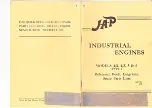
ENGINE SYSTEMS
11
of the engine cooling package. The HPCAC is an
air-to-air type cooler, and requires no connections to
the engine's cooling system.
The Exhaust Gas Recirculation (EGR) system
circulates cooled exhaust into the air inlet duct. The
dual stage EGR cooler provides regulated cooling of
the EGR gases before entering the air inlet duct. This
cools the combustion process, and reduces Nitrogen
Oxides (NO
X
) emissions.
The open crankcase breather system uses a
centrifugal Crankcase Oil Separator (CCOS) to return
oil mist to the crankcase, and vent the cleaned
crankcase gasses to the atmosphere. The CCOS is
part of the oil module. The breather system has been
redesigned, and uses no crankcase breather filter
or external piping. Blowby gases enter the CCOS
through the side of the crankcase.
The Inlet Air Heater system warms the incoming air
supply during engine cranking and several minutes
after cold engine start up to help reduce emissions.
The Navistar
®
Engine Brake by Jacobs
®
is optional
for Navistar
®
N13 engine displacements. The engine
brake is a compression release system that provides
additional vehicle braking performance. The operator
can control the engine brake for different operating
conditions.
Optional Equipment
Optional cold climate features available are an oil pan
heater and a coolant heater. Both heaters use an
electric element to warm engine fluids in cold weather.
The oil pan heater warms engine oil to ensure
optimum oil flow to engine components.
The coolant heater warms the engine coolant
surrounding the cylinders. Warmed engine coolant
increases fuel economy and aids start-up in cold
weather.
Chassis Mounted Equipment
•
The chassis mounted fuel filter/water separator
removes a majority of the water and foreign
particles that may enter the fuel system from the
supply tank(s). This filter works with the engine
mounted fuel module to eliminate foreign matter
and moisture from the fuel before entering the
fuel injection system.
•
The Low Temperature Radiator (LTR) regulates
the
temperature
of
the
LPCAC
and
the
low-temperature stage of the EGR cooler. The
LTR is mounted in front of the radiator cooling
package, and requires connections to the engine
cooling system.
•
The HPCAC lowers temperature after the air is
compressed by the turbochargers, and has no
connections to the engine cooling system. The
HPCAC is an air-to-air cooler. The HPCAC is
mounted in front of the radiator cooling package.
•
The Diesel Oxidation Catalyst (DOC) oxidizes
hydrocarbons and carbon monoxide, provides
heat for exhaust system warm-up,
aids in
temperature
management
for
the
Diesel
Particulate Filter (DPF), and oxidizes NO into
NO
2
for passive DPF regeneration. The DOC is
monitored by the Aftertreatment Control Module
(ACM) using one Diesel Oxidation Catalyst Inlet
Temperature (DOCIT) sensor positioned at the
DOC inlet, and one Diesel Particulate Filter Inlet
Temperature (DPFIT) sensor positioned at the
DPF inlet.
•
The
DPF
temporarily
stores
carbon-based
particulates, oxidizes stored particulates, stores
non-combustible ash, and provides required
exhaust
back
pressure
for
proper
engine
performance. The DPF is monitored by the ACM
using the DOC / DPF temperature sensor module
installed on the DPF, and the Diesel Particulate
Filter Differential Pressure (DPFDP) / outlet
pressure sensor installed on or near the DPF.
•
The Selective Catalyst Reduction (SCR) catalyst
oxidizes Nitrogen Oxides (NOx) into Nitrogen gas
and water.
The SCR catalyst is monitored by
the ACM using a NOx IN sensor module installed
after the HP turbocharger outlet pipe, and a NOx
OUT sensor module installed after the outlet of the
SCR catalyst. An ammonia (NH
3
) sensor provides
feedback to the ACM related to Diesel Exhaust
Fluid (DEF) injection into the SCR catalyst.





































